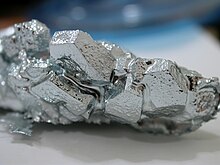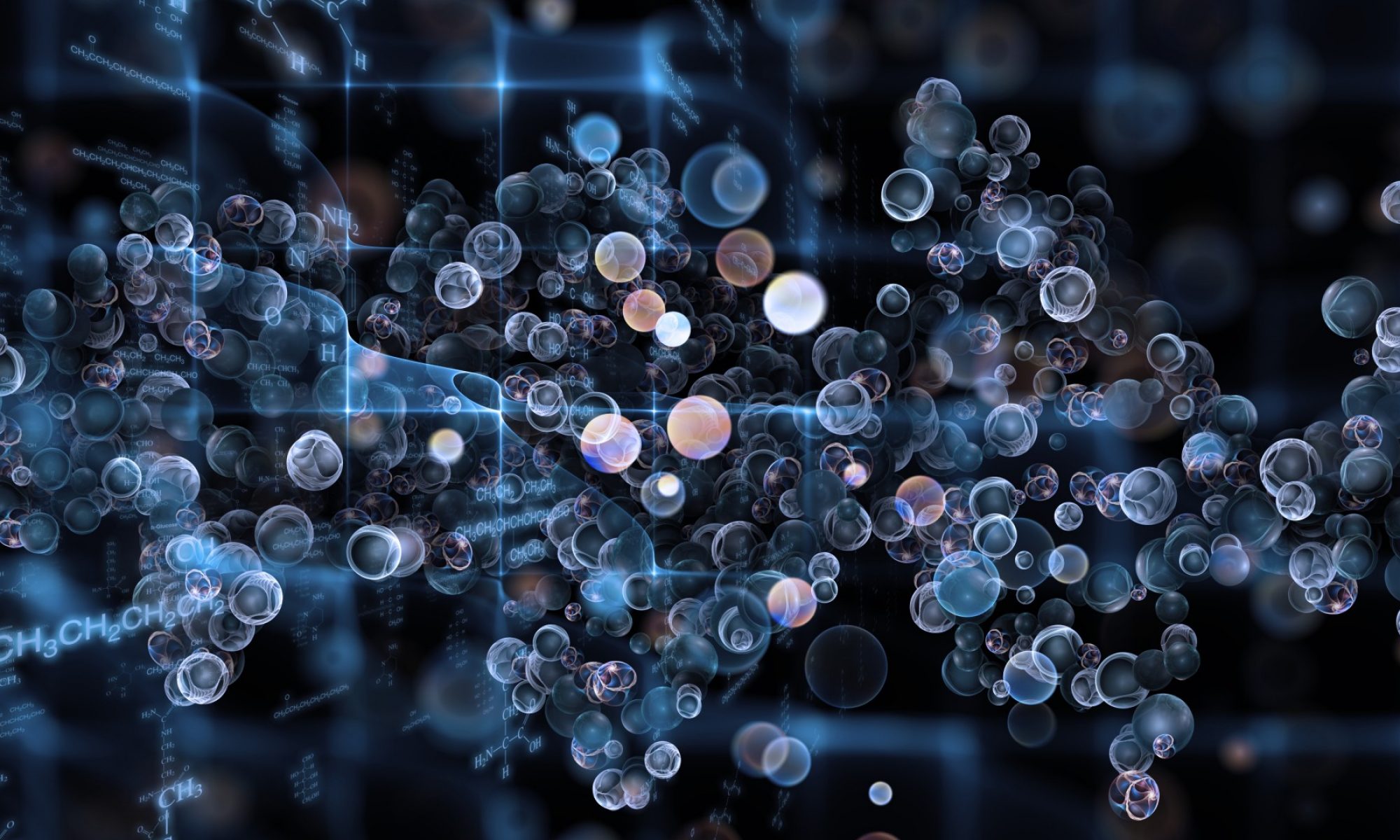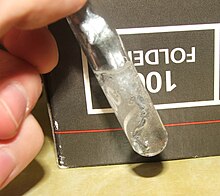A metal (from Greek μέταλλον métallon, “mine, quarry, metal”[1][2]) is a material (an element, compound, or alloy) that is typically hard when in solid state, opaque, shiny, and has good electrical and thermal conductivity. Metals are generally malleable—that is, they can be hammered or pressed permanently out of shape without breaking or cracking—as well as fusible (able to be fused or melted) and ductile (able to be drawn out into a thin wire).[3] About 91 of the 118 elements in the periodic table are metals; the others are nonmetals or metalloids. Some elements appear in both metallic and non-metallic forms.
Astrophysicists use the term “metal” to collectively describe all elements other than hydrogen and helium, the simplest two, in a star. The star fuses smaller atoms, mostly hydrogen and helium, to make larger ones over its lifetime. In that sense, the metallicity of an object is the proportion of its matter made up of all heavier chemical elements, not just traditional metals.[4]
Many elements and compounds that are not normally classified as metals become metallic under high pressures; these are formed as metallic allotropes of non-metals.
The strength and resilience of metals has led to their frequent use in high-rise building and bridge construction, as well as most vehicles, many home appliances, tools, pipes, non-illuminated signs and railroad tracks. Precious metals were historically used as coinage.
Metals in the periodic table
The elements which are considered as metals under ordinary conditions are shown in yellow on the periodic table below. The remaining elements are shown either as nonmetals or as metalloids of intermediate character.
| [hide]
Metals–nonmetals in the periodic table
|
||||||||||||||||||||||||||||||||||||||
|---|---|---|---|---|---|---|---|---|---|---|---|---|---|---|---|---|---|---|---|---|---|---|---|---|---|---|---|---|---|---|---|---|---|---|---|---|---|---|
| 1 | 2 | 3 | 4 | 5 | 6 | 7 | 8 | 9 | 10 | 11 | 12 | 13 | 14 | 15 | 16 | 17 | 18 | |||||||||||||||||||||
| Group → | ||||||||||||||||||||||||||||||||||||||
| ↓ Period | ||||||||||||||||||||||||||||||||||||||
| 1 | H | He | ||||||||||||||||||||||||||||||||||||
| 2 | Li | Be | B | C | N | O | F | Ne | ||||||||||||||||||||||||||||||
| 3 | Na | Mg | Al | Si | P | S | Cl | Ar | ||||||||||||||||||||||||||||||
| 4 | K | Ca | Sc | Ti | V | Cr | Mn | Fe | Co | Ni | Cu | Zn | Ga | Ge | As | Se | Br | Kr | ||||||||||||||||||||
| 5 | Rb | Sr | Y | Zr | Nb | Mo | Tc | Ru | Rh | Pd | Ag | Cd | In | Sn | Sb | Te | I | Xe | ||||||||||||||||||||
| 6 | Cs | Ba | La | Ce | Pr | Nd | Pm | Sm | Eu | Gd | Tb | Dy | Ho | Er | Tm | Yb | Lu | Hf | Ta | W | Re | Os | Ir | Pt | Au | Hg | Tl | Pb | Bi | Po | At | Rn | ||||||
| 7 | Fr | Ra | Ac | Th | Pa | U | Np | Pu | Am | Cm | Bk | Cf | Es | Fm | Md | No | Lr | Rf | Db | Sg | Bh | Hs | Mt | Ds | Rg | Cn | Nh | Fl | Mc | Lv | Ts | Og | ||||||
|
||||||||||||||||||||||||||||||||||||||
Structure and bonding
The atoms of metallic substances are typically arranged in one of three common crystal structures, namely body-centered cubic (bcc), face-centered cubic (fcc), and hexagonal close-packed (hcp). In bcc, each atom is positioned at the center of a cube of eight others. In fcc and hcp, each atom is surrounded by twelve others, but the stacking of the layers differs. Some metals adopt different structures depending on the temperature.[5]
Atoms of metals readily lose their outer shell electrons, resulting in a free flowing cloud of electrons within their otherwise solid arrangement. This provides the ability of metallic substances to easily transmit heat and electricity. While this flow of electrons occurs, the solid characteristic of the metal is produced by electrostatic interactions between each atom and the electron cloud. This type of bond is called a metallic bond.[6]
Properties
Chemical
Metals are usually inclined to form cations through electron loss,[6] reacting with oxygen in the air to form oxides over various timescales (iron rusts over years, while potassium burns in seconds). Examples:
- 4 Na + O2 → 2 Na2O (sodium oxide)
- 2 Ca + O2 → 2 CaO (calcium oxide)
- 4 Al + 3 O2 → 2 Al2O3 (aluminium oxide).
The transition metals (such as iron, copper, zinc, and nickel) are slower to oxidize because they form a passivating layer of oxide that protects the interior. Others, like palladium, platinum and gold, do not react with the atmosphere at all. Some metals form a barrier layer of oxide on their surface which cannot be penetrated by further oxygen molecules and thus retain their shiny appearance and good conductivity for many decades (like aluminium, magnesium, some steels, and titanium). The oxides of metals are generally basic, as opposed to those of nonmetals, which are acidic. Exceptions are largely oxides with very high oxidation states such as CrO3, Mn2O7, and OsO4, which have strictly acidic reactions.
Painting, anodizing or plating metals are good ways to prevent their corrosion. However, a more reactive metal in the electrochemical seriesmust be chosen for coating, especially when chipping of the coating is expected. Water and the two metals form an electrochemical cell, and if the coating is less reactive than the coatee, the coating actually promotes corrosion.
Physical

Gallium crystals
Metals in general have high electrical conductivity, high thermal conductivity, and high density. Typically they are malleable and ductile, deforming under stress without cleaving.[6] In terms of optical properties, metals are shiny and lustrous. Sheets of metal beyond a few micrometres in thickness appear opaque, but gold leaf transmits green light.
Although most metals have higher densities than most nonmetals,[6] there is wide variation in their densities, lithium being the least dense solid element and osmium the densest. The alkali and alkaline earth metals in groups I A and II A are referred to as the light metals because they have low density, low hardness, and low melting points.[6] The high density of most metals is due to the tightly packed crystal lattice of the metallic structure. The strength of metallic bonds for different metals reaches a maximum around the center of the transition metal series, as those elements have large amounts of delocalized electrons in tight binding type metallic bonds. However, other factors (such as atomic radius, nuclear charge, number of bonds orbitals, overlap of orbital energies and crystal form) are involved as well.[6]
Electrical

Filling of the electronic states in various types of materials at equilibrium. Here, height is energy while width is the density of available states for a certain energy in the material listed. The shade follows the Fermi–Dirac distribution (black = all states filled, white = no state filled). In metals and semimetals the Fermi level EF lies inside at least one band. In insulators and semiconductors the Fermi level is inside a band gap; however, in semiconductors the bands are near enough to the Fermi level to be thermally populated with electrons or holes.
The electrical and thermal conductivities of metals originate from the fact that their outer electrons are delocalized. This situation can be visualized by seeing the atomic structure of a metal as a collection of atoms embedded in a sea of highly mobile electrons. The electrical conductivity, as well as the electrons’ contribution to the heat capacity and heat conductivity of metals can be calculated from the free electron model, which does not take into account the detailed structure of the ion lattice.
When considering the electronic band structure and binding energy of a metal, it is necessary to take into account the positive potential caused by the specific arrangement of the ion cores—which is periodic in crystals. The most important consequence of the periodic potential is the formation of a small band gap at the boundary of the Brillouin zone. Mathematically, the potential of the ion cores can be treated by various models, the simplest being the nearly free electron model.
Mechanical
Mechanical properties of metals include ductility, i.e. their capacity for plastic deformation. Reversible elastic deformation in metals can be described by Hooke’s Law for restoring forces, where the stress is linearly proportional to the strain. Forces larger than the elastic limit, or heat, may cause a permanent (irreversible) deformation of the object, known as plastic deformation or plasticity. This irreversible change in atomic arrangement may occur as a result of:
- The action of an applied force (or work). An applied force may be tensile (pulling) force, compressive (pushing) force, shear, bending or torsion (twisting) forces.
- A change in temperature (heat). A temperature change may affect the mobility of the structural defects such as grain boundaries, point vacancies, line and screw dislocations, stacking faults and twins in both crystalline and non-crystalline solids. The movement or displacement of such mobile defects is thermally activated, and thus limited by the rate of atomic diffusion.

Hot metal work from a blacksmith.
Viscous flow near grain boundaries, for example, can give rise to internal slip, creep and fatigue in metals. It can also contribute to significant changes in the microstructure like grain growth and localized densification due to the elimination of intergranular porosity. Screw dislocationsmay slip in the direction of any lattice plane containing the dislocation, while the principal driving force for “dislocation climb” is the movement or diffusion of vacancies through a crystal lattice.
In addition, the nondirectional nature of metallic bonding is also thought to contribute significantly to the ductility of most metallic solids. When the planes of an ionic bond slide past one another, the resultant change in location shifts ions of the same charge into close proximity, resulting in the cleavage of the crystal; such shift is not observed in covalently bonded crystals where fracture and crystal fragmentation occurs.[7]
Alloys
An alloy is a mixture of two or more elements in which the main component is a metal. Most pure metals are either too soft, brittle or chemically reactive for practical use. Combining different ratios of metals as alloys modifies the properties of pure metals to produce desirable characteristics. The aim of making alloys is generally to make them less brittle, harder, resistant to corrosion, or have a more desirable color and luster. Of all the metallic alloys in use today, the alloys of iron (steel, stainless steel, cast iron, tool steel, alloy steel) make up the largest proportion both by quantity and commercial value. Iron alloyed with various proportions of carbon gives low, mid and high carbon steels, with increasing carbon levels reducing ductility and toughness. The addition of silicon will produce cast irons, while the addition of chromium, nickel and molybdenum to carbon steels (more than 10%) results in stainless steels.
Other significant metallic alloys are those of aluminium, titanium, copper and magnesium. Copper alloys have been known since prehistory—bronze gave the Bronze Age its name—and have many applications today, most importantly in electrical wiring. The alloys of the other three metals have been developed relatively recently; due to their chemical reactivity they require electrolytic extraction processes. The alloys of aluminium, titanium and magnesium are valued for their high strength-to-weight ratios; magnesium can also provide electromagnetic shielding[citation needed]. These materials are ideal for situations where high strength-to-weight ratio is more important than material cost, such as in aerospace and some automotive applications.
Alloys specially designed for highly demanding applications, such as jet engines, may contain more than ten elements.
Categories
Base metal
In chemistry, the term base metal is used informally to refer to a metal that is easily oxidized or corroded, and reacts easily with dilute hydrochloric acid (HCl) to form metal chloride and hydrogen. Examples include iron, nickel, lead and zinc. Copper is considered a base metal as it is oxidized relatively easily, although it does not react with HCl. Base metal is commonly used in opposition to noble metal.
In alchemy, a base metal was a common and inexpensive metal, as opposed to precious metals, mainly gold and silver. A longtime goal of the alchemists was the transmutation of base metals into precious metals.
In numismatics, coins in the past derived their value primarily from the precious metal content. Most modern currencies are fiat currency, allowing the coins to be made of base metal.
Ferrous metal
The term “ferrous” is derived from the Latin word meaning “containing iron”. This can include pure iron, such as wrought iron, or an alloy such as steel. Ferrous metals are often magnetic, but not exclusively.
Noble metal
Noble metals are metals that are resistant to corrosion or oxidation,[8] unlike most base metals. They tend to be precious metals, often due to perceived rarity. Examples include gold, platinum, silver, rhodium, iridium and palladium.
Precious metal
A precious metal is a rare metallic chemical element of high economic value.[9]
Chemically, the precious metals are less reactive than most elements, have high luster and high electrical conductivity. Historically, precious metals were important as currency, but are now regarded mainly as investment and industrial commodities. Gold, silver, platinum and palladiumeach have an ISO 4217 currency code. The best-known precious metals are gold and silver. While both have industrial uses, they are better known for their uses in art, jewelry, and coinage. Other precious metals include the platinum group metals: ruthenium, rhodium, palladium, osmium, iridium, and platinum, of which platinum is the most widely traded.
The demand for precious metals is driven not only by their practical use, but also by their role as investments and a store of value.[10] Palladium and platinum are, as of fall 2017, valued at about three quarters the price of gold. Silver is substantially less expensive than these metals, but is often traditionally considered a precious metal for its role in coinage and jewelry.
Heavy metal
A heavy metal is any relatively dense metal or metalloid.[11] More specific definitions have been proposed, but none have obtained widespread acceptance. Some heavy metals have niche uses, or are notably toxic; some are essential in trace amounts.
Extraction
Metals are often extracted from the Earth by means of mining ores that are rich sources of the requisite elements, such as bauxite. Ore is located by prospecting techniques, followed by the exploration and examination of deposits. Mineral sources are generally divided into surface mines, which are mined by excavation using heavy equipment, and subsurface mines.
Once the ore is mined, the metals must be extracted, usually by chemical or electrolytic reduction. Pyrometallurgy uses high temperatures to convert ore into raw metals, while hydrometallurgy employs aqueous chemistry for the same purpose. The methods used depend on the metal and their contaminants.
When a metal ore is an ionic compound of that metal and a non-metal, the ore must usually be smelted—heated with a reducing agent—to extract the pure metal. Many common metals, such as iron, are smelted using carbon as a reducing agent. Some metals, such as aluminium and sodium, have no commercially practical reducing agent, and are extracted using electrolysis instead.[12][13]
Sulfide ores are not reduced directly to the metal but are roasted in air to convert them to oxides.




